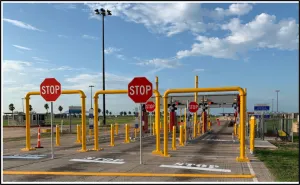EL PASO, Texas – U.S. Customs and Border Protection will begin construction of Low Energy Portal (LEP) scanning systems at the Bridge of the Americas international crossing in El Paso March 8. The systems will be placed in the passenger vehicle queuing areas south of the primary inspection booths and scan arriving vehicular traffic.
“The LEP system will scan arriving traffic and the imagery generated will be used by CBP to identify potential threats in a timely and efficient manner,” said CBP El Paso Port Director Ray Provencio. “The systems will supplement existing non-intrusive inspection technology, enhance border security, and will not impede current traffic flows or wait times.”
Initial construction will begin on the west side of the bridge and move east during installation. The construction is not expected to impede arriving northbound traffic. Port traffic will be routed around construction zones but access to all 14 inspection booths will remain. In addition, contractors plan to work during the night to further reduce any impact on northbound vehicle traffic. The goal is to have construction completed by late April with implementation to begin in the early summer.
Once operational all arriving vehicles will pass through the LEP systems after they cross the international boundary and before they reach the primary inspection booth. CBP personnel will review the imagery generated by the system and follow through with additional screening if any anomalies or issues are noted. There will be an option available for those who elect to not drive through the LEP system utilizing existing inspection protocols.
In 2020, Congress appropriated $59 million for CBP to procure and install these non-intrusive inspection systems.
CBP utilizes Non-Intrusive Inspection equipment to aid in the detection of illicit narcotics. The NII systems program supports the detection and prevention of contraband, including weapons, weapons of mass effect or destruction, drugs, currency, and other illegal merchandise, from entering or furthering their entry into the United States, while supporting a minimal impact on the flow of legitimate commerce. This program is an essential aspect of the CBP’s layered enforcement strategy. This technology includes but is not limited to: vehicle, handheld and baggage X-rays, presumptive identification devices for chemicals and density meters.
The use of NII technologies increases the probability of CBP’s Office of Field Operations detecting weapons and destructive devices, as well as narcotics that may be hidden in conveyances, and preventing them from entering or furthering entry into the United States. NII technologies aid in the identification and prevention of undeclared currency and contraband being smuggled into the United States.
In addition to the Bridge of the Americas LEP system, CBP will also place the systems at the Ysleta, Santa Teresa, Fort Hancock, Tornillo and Presidio crossings in the months ahead. CBP is also adding Cargo Multi Energy Portal (MEP) scanning systems in the cargo environment. The first MEP system in the El Paso area is currently under construction at the Santa Teresa port of entry. MEP systems are also slated for cargo facilities at the Bridge of the Americas, Presidio and Columbus ports. New high energy rail scanning systems are planned to be introduced at the two international rail crossings in south El Paso adjacent to the Paso Del Norte crossing.


